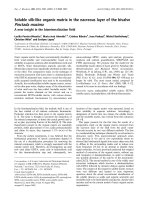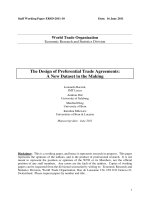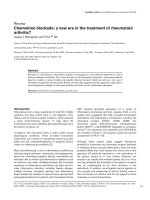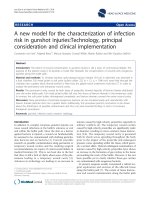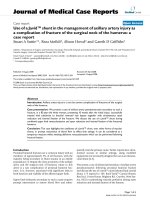Neuroimaging as a new tool in the toolbox of psychological science
Bạn đang xem bản rút gọn của tài liệu. Xem và tải ngay bản đầy đủ của tài liệu tại đây (165.21 KB, 7 trang )
Seediscussions,stats,andauthorprofilesforthispublicationat: />
NeuroimagingasaNewToolintheToolboxof
PsychologicalScience
ArticleinCurrentDirectionsinPsychologicalScience·April2008
DOI:10.1111/j.1467-8721.2008.00550.x
CITATIONS
READS
51
152
3authors:
JohnTCacioppo
GaryBerntson
598PUBLICATIONS62,061CITATIONS
259PUBLICATIONS20,099CITATIONS
UniversityofChicago
SEEPROFILE
TheOhioStateUniversity
SEEPROFILE
HowardNusbaum
UniversityofChicago
163PUBLICATIONS5,020CITATIONS
SEEPROFILE
AllcontentfollowingthispagewasuploadedbyHowardNusbaumon04April2014.
Theuserhasrequestedenhancementofthedownloadedfile.Allin-textreferencesunderlinedinblueareaddedtotheoriginaldocument
andarelinkedtopublicationsonResearchGate,lettingyouaccessandreadthemimmediately.
CURRENT DIRECTIONS IN PSYCHOLOGICAL S CIENCE
Commentary
Neuroimaging as a New Tool in
the Toolbox of Psychological
Science
John T. Cacioppo,1 Gary G. Berntson,2 and Howard C. Nusbaum1
1
The University of Chicago and 2Ohio State University
ABSTRACT—During
the past quarter century, advances in
imaging technology have helped transform scientific fields.
As important as the data made available by these new
technologies have been, equally important have been the
guides provided by existing theories and the converging
evidence provided by other methodologies. The field of
psychological science is no exception. Neuroimaging is an
important new tool in the toolbox of psychological science,
but it is most productive when its use is guided by psychological theories and complemented by converging
methodologies including (but not limited to) lesion, electrophysiological, computational, and behavioral studies.
Based on this approach, the articles in this special issue
specify neural mechanisms involved in perception, attention, categorization, memory, recognition, attitudes, social
cognition, language, motor coordination, emotional regulation, executive function, decision making, and depression.
Understanding the contributions of individual and functionally connected brain regions to these processes benefits
psychological theory by suggesting functional representations and processes, constraining these processes, producing means of falsifying hypotheses, and generating new
hypotheses. From this work, a view is emerging in which
psychological processes represent emergent properties of a
widely distributed set of component processes.
KEYWORDS—functional
magnetic resonance imaging; cognitive processes; social processes; clinical processes; developmental processes
Address correspondence to John T. Cacioppo, Center for Cognitive
and Social Neuroscience, The University of Chicago, 5848 S. University Avenue, Chicago, Illinois 60637; e-mail: cacioppo@uchicago.
edu.
62
New imaging technologies are having a demonstrable impact on
the landscape of scientific research. The most expensive imaging
instrument, and the most vivid example, is the Hubble Space
Telescope. The Hubble telescope was deployed in April 1990
and has undergone three major repairs and upgrades since that
time. It has also provided data and images at a resolution Galileo
Galilei could not have imagined when, early in the 17th century,
he discovered the craters on the moon, sunspots, the rings of
Saturn, and the moons of Jupiter by gazing through his first crude
telescope. The discoveries made possible by the high-resolution
data and images from the Hubble nearly four centuries later
include massive black holes at the center of galaxies, the
existence of precursors to planetary systems like our own, and
a greater quantity and distribution of dark matter than expected.
As important as were the data provided by the Hubble Telescope,
however, these discoveries were dependent on extant theories
and methodologies. The discovery of stellar black holes at the
centers of galaxies, for instance, was guided by general relativity
theory and supported by research using several converging
methodologies (e.g., Dolan, 2001).
Developments in neuroimaging during the past quarter
century have increasingly made it possible to investigate the
differential involvement of particular brain regions in normal
and disordered thought in humans. Previously, studies of the
neurophysiological structures and functions associated with
psychological states and processes were limited primarily to
animal models, postmortem examinations, electrophysiological
measures, and observations of the occasional unfortunate individual who suffered trauma to or disorders of the brain (e.g.,
Raichle, 2003). The detailed three-dimensional color images
provided by neuroimaging, modeling statistical properties of the
working brain, have captured the imagination of the public and the
scientific community, shaped funding priorities at federal funding
agencies and foundations, and produced a dramatic growth in
scientific papers and journals in the area (Cacioppo et al., 2007).
Copyright r 2008 Association for Psychological Science
Volume 17—Number 2
John T. Cacioppo, Gary G. Berntson, and Howard C. Nusbaum
This special issue of Current Directions in Psychological Science
summarizes recent theoretical advances in various fields of
psychological science that are attributable in part to the use of
neuromaging technology—most prominently, functional magnetic resonance imaging (fMRI). Although reading these reviews
leaves the impression that neuroimaging is an important new tool
in the toolbox of psychological science, one cannot help but also
be impressed that neuroimaging—like the Hubble Space Telescope—is most productive scientifically when its use is guided by
extant theories and complemented by converging methodologies.
In the typical neuroimaging study, psychological states and
processes are manipulated and activation in different brain
regions is measured. The logic of this design is best suited
for drawing inferences about the differential involvement of particular brain regions in specific psychological operations.
For instance, when Poeppel and Monahan (2008, this issue) ask
how speech signals are represented and processed in the brain,
they are using neuroimaging along with converging methods
from psychological science, and guided by the blueprint of
competing theoretical accounts for speech perception, to investigate the differential involvement of particular brain regions
in psychological states and processes. It is also possible under
certain conditions to draw reasonable inferences about psychological operations based on regions of brain activation (Cacioppo
& Berntson, in press; Cacioppo & Tassinary, 1990; Henson,
2006; Poldrack, 2006; Sarter, Berntson, & Cacioppo, 1996).
Across the articles in this special issue, evidence from lesion
studies, animal studies, neuroimaging, single-cell recording,
event-related brain potentials, transcranial magnetic stimulation,
computational modeling, and behavior is reviewed to investigate
the brain regions involved in perception, attention, categorization,
memory, recognition, attitudes, social cognition, language, motor
coordination, emotional regulation, executive function, decision
making, and depression. Together, the evidence converges on the
view that psychological states and processes are mediated by a
network of distributed, often recursively connected, interacting
brain regions, with the different areas making specific, often taskmodulated contributions (see Poeppel & Monahan, 2008).
DISTRIBUTED NETWORKS INVOLVED IN COGNITIVE
REPRESENTATIONS AND FUNCTION
Humans are visual creatures. The visual properties of scenes
drive neurons in the lateral geniculate nucleus of the thalamus,
and visual perception has been found to involve a dorsal stream,
or ‘‘where pathway,’’ and a ventral stream, or ‘‘what pathway.’’
The dorsal (where) stream includes the areas designated V1, V2,
V5/MT, and the inferior parietal lobule and is associated with
motion, representation of object locations, and control of the
eyes and arms when visual information is used to guide saccades
or reaching. The ventral (what) stream includes the areas V1,
V2, V4, and the inferior temporal lobe (areas that include
the lateral occipital complex and the fusiform gyrus) and is
Volume 17—Number 2
associated with form recognition, object representation, face
recognition, and long-term memory (Engel, 2008, this issue).
Grill-Spector and Sayres (2008, this issue) provide evidence
that changes in the size, position, orientation, and other aspects
of physical appearance of faces activate the lateral occipital
complex; differences in the identity of individuals are related
to adaptation responses in the fusiform gyrus; and changes
in facial expression and gaze direction involve the superior
temporal sulcus.
Different theoretical representations and decompositions of
speech perception into processing components are described,
and the neural outcomes associated with each of these theoretical representations are reviewed, by Poeppel and Monahan
(2008). Here, too, the evidence suggests the involvement of a
specialized, interconnected set of neural regions that are widely
distributed across the temporal, parietal, and frontal lobes.
Specifically, the early spectrotemporal analyses involve bilateral
auditory cortices and the superior temporal cortex, and phonological analyses involve the middle and posterior portions of the
superior temporal sulcus. The processing streams then appear to
divide into a ventral stream—which maps auditory and phonological representations onto lexical conceptual representations
and involves the middle temporal gyrus and inferior temporal
sulcus—and a dorsal stream—which maps auditory and phonological representations onto articulatory and motor representations and involves the Sylvian parietotemporal area, posterior
frontal gyrus, premotor cortex, and anterior insula (Poeppel &
Monahan, 2008).
The attentional modulation of perceptual processes is influenced by motivational states and goals as well as by stimulus
properties. Visual attentional control can modulate neural
activity in the lateral geniculate nucleus and superior colliculus,
as well as in the posterior parietal cortex (specifically, the regions of the superior parietal lobule and the lateral intraparietal
area within the intraparietal sulcus) and the frontal eye field and
supplementary eye field within the prefrontal cortex (Yantis,
2008, this issue). These perceptual and attentional processes
contribute to the acquisition of knowledge about the world that
is organized categorically. Barsalou (2008, this issue) notes
that the dominant theory in cognitive science posits that this
knowledge is represented in an abstract, amodal fashion and
constitutes semantic memory. He shows in his review, however,
that categorical knowledge includes modal representations
using the same neural mechanisms involved in perception,
affect, and action. In Barsalou’s view, the representation of a
category involves a neural circuit distributed across the relevant
modalities, all of which can become activated during conceptual
processing. Thus, conceptual processing can be viewed as an
embodied rather than purely abstract process.
How does categorical knowledge being represented in this
distributed, modal fashion square with the neuroscientific
evidence for differences in the localization of short- and longterm memory processes? Nee, Berman, Moore, and Jonides
63
Neuroimaging and Psychological Science
(2008, this issue) suggest that the evidence supporting the
qualitative distinction between short- and long-term storage
processes has been misinterpreted, and they suggest that the
data instead support a unitary model of memory in which the
same regions of the brain that represent perception, action, and
affect are involved in both short- and long-term storage processes. That is, short- and long-term memories do not differ in
representation but in the activation by attention, which in turn
involves a frontal biasing (i.e., maintenance) of representational
cortices (e.g., frontal eye fields and intraparietal sulcus for
spatial representations; superior temporal sulcus and Sylvian
parietotemporal area for phonological and articulatory representations). For instance, damage in the presylvian region produces deficits in short- and long-term memory that depends on
phonological material, and the greater prevalence of such material in studies of short- than of long-term storage processes may
inadvertently have led to evidence that this region was involved
uniquely in short-term memory (Nee et al., 2008). Short- and
long-term memory retrieval also activates overlapping regions of
the left lateral frontal cortex, whereas the monitoring of retrieved
information, whether from short- or long-term memory, is
associated with the anterior prefrontal activation (cf. Cabeza,
Dulcos, Graham, & Nyberg, 2002).
Neuropsychological research dating back several decades suggested structures in the medial temporal lobe (e.g., the hippocampus) were involved in declarative rather than nondeclarative
learning. Unlike the distinction between short- and long-term
memory, the distinction between declarative and nondeclarative
learning is supported by neuroimaging research. For instance,
research by Knowlton and Foerde (2008, this issue) has shown that
when performance on a probabilistic classification task is based
on declarative memory performance the medial temporal lobe
is activated, whereas when performance on the task is based on
nondeclarative memory performance the striatum is activated.
Knowlton and Foerde (2008) also review evidence showing
that nondeclarative skill learning, at least for simple tasks, is associated with repetition suppression—reductions in the regions of
neural activation associated with the initial performances of a task
(e.g., the premotor region)—a finding that has been interpreted as
indicating a greater efficiency of processing in the neural structures involved in novice performance. Priming-related reductions,
on the other hand, are found in perceptual and prefrontal regions,
with only the latter associated with behavioral facilitation.
Knowlton and Foerde (2008) duly note, however, that activation in
the perceptual cortices may appear to be less important in the
extant literature in part because of the type of priming paradigms
that have been used in fMRI research.
The complexities of social living, such as recognizing individuals and groups, negotiating nontransitive social hierarchies
and shifting alliances, using language to communicate and
manipulate, and engaging in social exchanges over extended
periods and locales, place special demands on the capacities of
the human brain. Mitchell (2008, this issue) reviews evidence
64
that thinking about thinking people (e.g., impression formation,
social causality)—in contrast, for instance, to thinking about
physical causality—is associated with activation of the medial
prefrontal cortex, the right temporo-parietal junction, and the
medial parietal region (e.g., the precuneus/posterior cingulate
cortex). Mitchell (2008) suggests that the activation of the
medial prefrontal cortex appears to be involved whenever people
are obliged to consider the psychological characteristics of
another person, whereas the temporo-parietal junction appears
to be activated when the attentional and perceptual requirements of taking the perspective of another are invoked. The
medial parietal region, on the other hand, is activated during
the retrieval of episodic memories and self-knowledge, as well
as during the viewing of two or more interacting people (e.g.,
Iacoboni et al., 2004).
The brain has evolved to guide behavior in contextually
flexible, coordinated, and adaptive ways, and, as with attention,
there are top-down as well as bottom-up influences on the
orchestration of motor processes. Oliveira and Ivry (2008, this
issue) focus on the top-down influences in their discussion of
goals as higher-level action representations that connect sensory
and motor processes to guide response selection and motor
coordination. They review fMRI studies showing that motor
planning and externally guided movements are associated with
activity in the posterior superior parietal region and, at least for
externally guided movements, in premotor regions; internally
generated movements are associated with activity in the basal
ganglia, the anterior cingulate cortex, and inferior frontal and
parietal cortices; and conflicting action goals and effort are
associated with activity in medial frontal areas, including the
anterior cingulate cortex and presupplementary motor areas.
One suggestion that has emerged from this area of research
is that goal representation and action planning are not implemented simply as an abstract code but rather involve embodied
processes. Not unlike how Barsalou (2008) invokes modal
mechanisms, Rizzolati and Arbib (1998) and Skipper, Nusbaum,
and Small (2006) review evidence for the role of embodied
representations in categorization and language.
The fundamental idea that the motor system is important for
cognition and perception, through prior experience and mirror
neurons, has become an important contribution of neuroscience
to bolstering theoretical constructs in the psychology of embodied understanding. However, much of the work on the mirror
system in cognition and understanding has been carried out with
trained nonhuman primates or with adult humans. For any theory
of adult function to be viable, it is critical to understand the
development of these mechanisms. Diamond and Amso (2008,
this issue) review work on the neural substrates underlying
cognitive development, including the mirror-neuron system
and neonatal imitative behaviors and maternal touch and
gene expression. As the authors note, a major contribution of
neuroscience to theories of cognitive development is ‘‘demonstrating the remarkable role of experience in shaping the mind,
Volume 17—Number 2
John T. Cacioppo, Gary G. Berntson, and Howard C. Nusbaum
brain, and body’’ (p. 136). Such cross-cutting work is necessary
to begin to link biological development with learning and
experience. Moreover, as cognition can no longer be studied
in isolation from the social context of its use, this work suggests
the importance of understanding development within its social
context of parental interaction. Given the importance of social
context, then, it is important to go beyond the treatment
of specific processes to understand how such processes depend
on the goals they are directed at achieving.
To achieve one’s goals, one has to be able to represent
the likely rewards (and punishments) associated with different
decisions, encode the risk or certitude that the reward will
be obtained, update these representations, and act on the basis
of these representations. O’Doherty and Bossaerts (2008, this
issue) review evidence regarding the brain regions associated
with each of these components of decision making. Specifically,
they report that the encoding of reward expectation is associated
with activation of the orbitofrontal cortex, medial prefrontal
cortex, amygdala, and ventral striatum; recognizing greater risk
or uncertainty associated with obtaining a reward correlates with
increased activity in the anterior insula and lateral orbitofrontal
regions; updating of reward expectancies is associated with
the ventral striatum and orbitofrontal cortex; and selecting
one of several responses to obtain the greatest reward involves
the striatum, with the ventral striatum more involved in the
prediction of reward across the various options and the dorsal
striatum more involved in the selection among the alternatives
(O’Doherty & Bossaerts, 2008).
The frontal regions have long been thought to be involved
in executive functions such as formulating goals and plans;
selecting among options to achieve these goals; monitoring the
consequences of actions in light of one’s goals; and inhibiting,
switching and regulating one’s behaviors accordingly. Aron
(2008, this issue) reviews evidence that the initiation of a motor
response proceeds from the planning areas of the frontal cortex
to the putamen, globus pallidus, thalamus, primary motor cortex,
motor nucleus in the spinal cord, and finally to the muscles.
Being able to inhibit a motor response once it has been initiated
has obvious adaptive value, and Aron (2008) shows that this
inhibition involves the right inferior frontal cortex, which projects to the subthalamic nucleus (a region of the basal ganglia
that may act on the globus pallidus to block the motor response).
Monitoring for response conflicts, in turn, appears to involve the
dorsal anterior cingulate and the adjacent presupplementary
motor area, which, in turn, is connected to the right inferior
frontal cortex and subthalamic nucleus. Switching also involves
the presupplementary motor area and the right inferior frontal
cortex (Aron, 2008). This work has led to a model in which ‘‘the
[presupplementary motor area] may monitor for conflict between
an intended response and a countervailing signal . . . Then, when
such conflict is detected, the ‘brakes’ could be put on via the
connection between the right [inferior frontal cortex] and the
[subthalamic nucleus] region’’ (Aron, 2008, p. 127).
Volume 17—Number 2
Emotional regulation is another form of executive function
in which activity of the amygdala and insula cortex, which are
involved in emotional responding, is modulated by activity in the
prefrontal cortex (e.g., BA10, ventromedial prefrontal cortex,
dorsolateral prefrontal cortex) and anterior cingulate. Ochsner
and Gross (2008, this issue) review evidence that different
components of reappraisal processing correspond to different
areas of prefrontal activation: Selective attention and working
memory components are related to dorsal portions of the prefrontal cortex, language or response inhibition are related to
ventral portions of the prefrontal cortex, monitoring or control
processes are related to the dorsal anterior cingulate cortex, and
reflections on one’s emotional state are related to dorsal portions
of the medial prefrontal cortex. Although the correspondences
proposed by Ochsner and Gross (2008) do not match perfectly
those articulated by Aron (2008), the overlapping role for the
anterior cingulate is noteworthy in light of the notion that the
presupplementary motor area may be especially involved in the
monitoring and control of motor conflicts.
The complexities of daily living are simplified in part by the
formation of preferences and attitudes, which can serve as
behavioral guides and simplify decision making. These attitudes
can be explicit or implicit. Stanley, Phelps, and Banaji (2008,
this issue) review evidence suggesting that the activation
of implicit attitudes toward social groups (e.g., minorities) is
associated with increased activity in the amygdala, dorsolateral
prefrontal cortex, and anterior cingulate cortex. The cumulative
evidence to date suggests that the automatic evaluation of
a stimulus (e.g., social category) is associated with amygdala
activation, the monitoring for response conflicts (e.g., the extent
to which the stimulus elicits competing impulses) is associated
with anterior cingulate activation, and the regulation of those
impulses is associated with dorsolateral prefrontal activation.
Failures of effective emotional regulation can become costly
in personal, social, and economic terms when these failures become
systemic. Depression, for instance, has been estimated to cost more
than $43 billion per year in the United States (Greenberg, Stiglin,
Finkelstein, & Berndt, 1993). Understanding the variation in
biological systems that leads to individual differences in neural
mechanisms of emotional regulation is critical to understanding
how some systemic failures become chronic and debilitating.
Gotlib and Hamilton (2008, this issue) review evidence that
depressed individuals show less activity in the dorsolateral
prefrontal cortex and greater activation of the amygdala and
subgenual anterior cingulate cortex to emotional stimuli than do
healthy controls. Parallel findings for basal activity levels in
these brain regions are also noted. These findings are consistent
with Gotlib and Hamilton’s notion that depression is in large part
a disorder of emotion regulation in which the normal inhibitory
influence of limbic structures by the anterior cingulate and
dorsolateral prefrontal cortex is disrupted, although the
subgenual anterior cingulate cortex may play an especially
critical role in this dysregulation (Gotlib & Hamilton, 2008).
65
Neuroimaging and Psychological Science
Given the importance of the anterior cingulate and dorsolateral
prefrontal cortex in motor control, attention, and emotion,
the individual variation in function in these areas that can lead
to depression may also explain that disorder’s other associated
cognitive symptoms.
Indeed, understanding the relationship between biological
variation in neural mechanisms and psychological processes is
important beyond clinical problems. Kosslyn et al. (2002) and
Vogel and Awh (2008, this issue) have argued that, to bridge
the gap between psychological phenomena and their underlying
biological substrata, such variation should be regarded as
important data in its own right. Kosslyn et al. (2002) describe how
an idiographic approach can be used to address three types of
issues: the nature of the mechanisms that give rise to a specific
ability, the role of psychological or biological mediators of environmental challenges, and the existence of variables that have
nonadditive effects with other variables. Vogel and Awh (2008)
extend this argument in their discussion of three additional ways
in which an idiographic approach can contribute to psychological
theory: validating neurophysiological measures, demonstrating
associations among constructs, and demonstrating dissociations
among similar constructs. Thus, an idiographic approach, which
complements the more typical nomethetic approach, can be
applied in any domain to help elucidate psychological theory.
Together, the theory and data summarized in this special issue
of Current Directions in Psychological Science highlight the
notion that encephalization and the remarkable connectivity
in the human brain provide the substrate for the integration
of inputs from widely distributed neural regions (only some of
which are amenable to current brain-imaging technology) whose
activation and organization can be contextually determined. The
distributed nature of and substantial overlap among the extant
networks calls for a revision in our thinking about basic
psychological constructs. The early reliance on introspection as
a method of identifying elemental psychological processes led to
a recognition of the category error—the intuitively appealing but
often erroneous notion that the organization of psychological
phenomena maps in a one-to-one fashion onto the organization
of underlying neural substrates. Perception, memories, emotions,
and beliefs were each once thought to be localized in distinct
sites in the brain. The contributions to this special issue clearly
indicate that psychological and behavioral concepts do not each
map onto clear and identifiable ‘‘centers,’’ but rather that each
concept is associated with a distributed, interconnected set of
neural regions. What appears at one point in time to be a singular
theoretical construct (e.g., memory), when examined in conjunction with evidence from the brain (e.g., lesions, neuroimaging), may reveal a more complex and interesting organization at
both levels (e.g., declarative vs. procedural memory processes).
Conversely, what appeared to be distinct constructs (e.g.,
short- vs. long-term memory) may need to be reconsidered in light
of new neuroscientific evidence. We suspect we are far from seeing
the last of such revisions to psychological theories. It is only
66
through these revisions, and corresponding refinements in our
understanding and conceptions of the underlying neural functions,
that we can reduce the category error and move toward an
isomorphism between the psychological and biological domains.
Neuroimaging and work in neuroscience more generally are
reshaping the constructs that are being used to build psychological theories. Psychological research during the 20th century
resulted in many of the basic psychological elements derived
from introspection to be recast as the product of multiple,
more specific component processes. As illustrated by the articles
in this special issue, many of these component processes involve a network of distributed, often recursively connected,
interacting brain regions, with the different areas making
specific, often task-modulated contributions. Moreover, a single
neural region can often be involved in what have been treated
as very different psychological processes. One implication is that
what have been considered basic psychological or behavioral
processes are being conceptualized as manifestations of computations performed by networks of widely distributed sets of
neural regions.
How might these neural components be combined to produce
distinct psychological processes? One metaphor is the Lego set,
in which the computations performed in localized neural regions
are fixed (like distinct Lego pieces), but different pieces
and configurations of these building blocks produce different
psychological processes. An alternative metaphor is the periodic
table in chemistry, in which different neural component processes may have properties and affinities whose function (computation) depends on the network of areas with which they
are combined. There is no evidence at present to favor either
perspective, but the important point here is that they suggest
very different ways of thinking about neural activity and
psychological function.
In sum, neuroimaging work is leading to a rethinking of how
psychological and neural functions are parcelled. For instance,
the close proximity of motor control, emotional appraisal,
attention, working memory, and behavioral regulation suggests
that these functions may not be as separable as they are currently
treated and studied. We may well need a new lexicon of
constructs that are neither simply anatomical (e.g., Brodmann
area 6 vs. Brodmann area 44) nor psychological (e.g., attention,
memory), as we usher in a new era of psychological theory
in which what constitutes elemental component processes
(functional elements) are tied to specific neural mechanisms
(structural elements) and in which the properties of interrelated
networks of areas may indeed be more than the sum of the parts.
CONCLUSION
Critics who say neuroimaging is costly and has contributed little
if anything to psychological theory sometime appear to expect
the images of the working brain to come with labels regarding
their cognitive functions. Although an adequate specification of
Volume 17—Number 2
John T. Cacioppo, Gary G. Berntson, and Howard C. Nusbaum
neurobiology should contribute to our understanding of cognitive architecture and function, our understanding of the relevant
neurobiology is influenced strongly by our extant theoretical
models regarding cognitive architecture and function (see
Hagoort, 2008, this issue). The contributions to this special issue
demonstrate that neuroimaging is an important new tool in the
toolbox of psychological science, but one that is most productive
scientifically when its use is guided by psychological theories
and complemented by converging methodologies. This approach,
in which theory and converging methods are used hand in hand to
expand our understanding of the neural mechanisms involved in
cognition and the contributions of individual and functionally
connected brain regions to these processes, promises to advance
psychological theory by suggesting functional representations
and processes, by imposing significant constraints on these processes, and by producing not only new behavioral hypotheses but
also new means of falsifying theoretical hypotheses.
Acknowledgments—Preparation of this paper was supported
by grants from the National Institute of Mental Health (Grant No.
P50 MH72850) and the John Templeton Foundation.
REFERENCES
Aron, A.R. (2008). Progress in executive-function research: From
tasks to functions to regions to networks. Current Directions in
Psychological Science, 17, 124–129.
Barsalou, L.W. (2008). Cognitive and neural contributions to
understanding the conceptual system. Current Directions in
Psychological Science, 17, 91–95.
Cabeza, R., Dulcos, F., Graham, R., & Nyberg, L. (2002). Similarities
and differences in the neural correlates of episodic memory
retrieval and working memory. Neuroimage, 16, 317–330.
Cacioppo, J.T., Amaral, D.G., Blanchard, J.J., Cameron, J.L., Carter,
C.S., Crews, D., et al. (2007). Social neuroscience: Progress and
implications for mental health. Perspectives on Psychological
Science, 2, 99–123.
Cacioppo, J.T., & Berntson, G.G. (in press). Integrative neuroscience
for the behavioral sciences: Implications for inductive inference.
In G.G. Berntson & J.T. Cacioppo (Eds.), Handbook of neuroscience
for the behavioral sciences. New York: Wiley.
Cacioppo, J.T., & Tassinary, L.G. (1990). Inferring psychological significance from physiological signals. American Psychologist, 45,
16–28.
Diamond, A., & Amso, D. (2008). Contributions of neuroscience to
our understanding of cognitive development. Current Directions
in Psychological Science, 17, 136–141.
Dolan, J.F. (2001). How to find a stellar black hole. Science, 292,
1079–1080.
Engel, S.A. (2008). Computational cognitive neuroscience of the visual
system. Current Directions in Psychological Science, 17, 68–72.
Gotlib, I.H., & Hamilton, J.P. (2008). Neuroimaging and depression:
Current status and unresolved issues. Current Directions in
Psychological Science, 17, 159–163.
Greenberg, P.E., Stiglin, L.E., Finkelstein, S.N., & Berndt, E.R. (1993).
The economic burden of depression in 1990. Journal of Clinical
Psychiatry, 54, 405–418.
Volume 17—Number 2
View publication stats
Grill-Spector, K., & Sayres, R. (2008). Object recognition: Insights from
advances in fMRI methods. Current Directions in Psychological
Science, 17, 73–79.
Hagoort, P. (2008). Should psychology ignore the language of the brain?
Current Directions in Psychological Science, 17, 96–101.
Henson, R. (2006). Forward inference using functional neuroimaging:
Dissociations versus associations. Trends in Cognitive Sciences, 10,
64–69.
Iacoboni, M., Lieberman, M.D., Knowlton, B.J., Molnar-Szakacs, I.,
Mortiz, M., Throop, C.J., & Fiske, A.P. (2004). Watching social
interactions produces dorsomedial prefrontal and medial parietal
BOLD fMRI signal increases compared to a resting baseline.
Neuroimage, 21, 1167–1173.
Knowlton, B.J., & Foerde, K. (2008). Neural representations of
nondeclarative memories. Current Directions in Psychological
Science, 17, 107–111.
Kosslyn, S.M., Cacioppo, J.T., Davidson, R.J., Hugdahl, K., Lovallo,
W.R., Spiegel, D., & Rose, R. (2002). Bridging psychology
and biology: The analysis of individuals in groups. American
Psychologist, 57, 341–351.
Mitchell, J.P. (2008). Contributions of functional neuroimaging to social cognition. Current Directions in Psychological Science, 17, 142–146.
Nee, D.E., Berman, M.G., Moore, K.S., & Jonides, J. (2008). Neuroscientific evidence about the distinction between short- and long-term
memory. Current Directions in Psychological Science, 17, 102–106.
Ochsner, K.N., & Gross, J.J. (2008). Cognitive emotion regulation: Insights from social cognitive and affective neuroscience. Current
Directions in Psychological Science, 17, 153–158.
O’Doherty, J.P., & Bossaerts, P. (2008). Towards a mechanistic
understanding of human decision making: Contributions of
functional neuroimaging. Current Directions in Psychological
Science, 17, 119–123.
Oliveira, F.T.P., & Ivry, R.B. (2008). The representation of action:
Insights from bimanual coordination. Current Directions in
Psychological Science, 17, 130–135.
Poeppel, D., & Monahan, P.J. (2008). Speech perception: Cognitive
foundations and cortical implementation. Current Directions in
Psychological Science, 17, 80–85.
Poldrack, R.A. (2006). Can cognitive processes be inferred from
neuroimaging data? Trends in Cognitive Sciences, 10, 59–63.
Raichle, M.E. (2003). Functional brain imaging and human brain
function. The Journal of Neuroscience, 23, 3959–3962.
Rizzolatti, G., & Arbib, M.A. (1998). Language within our grasp. Trends
in Neuroscience, 21, 188–194.
Sarter, M., Berntson, G.G., & Cacioppo, J.T. (1996). Brain imaging and
cognitive neuroscience: Toward strong inference in attributing
function to structure. American Psychologist, 51, 13–21.
Skipper, J.I., Nusbaum, H.C., & Small, S.L. (2006). Lending a helping
hand to hearing: Another motor theory of speech perception. In
M.A. Arbib (Ed.), Action to language via the mirror neuron system
(pp. 250–285). New York: Cambridge University Press.
Stanley, D., Phelps, E., & Banaji, M. (2008). The neural basis of implicit
attitudes. Current Directions in Psychological Science, 17, 164–
170.
Vogel, E.K., & Awh, E. (2008). How to exploit diversity for scientific
gain: Using individual differences to constrain cognitive theory.
Current Directions in Psychological Science, 17, 171–176.
Yantis, S. (2008). The neural basis of selective attention: Cortical
sources and targets of attentional modulation. Current Directions in
Psychological Science, 17, 86–90.
67
